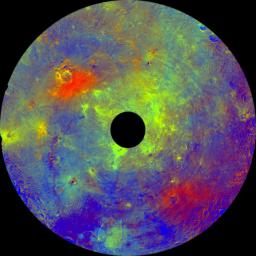
Figure 1
Click on the image for larger view
This image using color data obtained by the framing camera aboard NASA's Dawn spacecraft shows Vesta's southern hemisphere in color, centered on the Rheasilvia formation. Rheasilvia is an impact basin measured at about 290 miles (467 kilometers) in diameter with a central mound reaching about 14 miles (23 kilometers) high.The black hole in the middle of the polar stereographic projection (circular image) is data that have been omitted due to the angle between the sun, Vesta and the spacecraft.
Scientists assigned different colors for the ratios of two wavelengths of radiation detected by the framing camera to indicate areas that are relatively redder or bluer. The red indicates wavelengths at 750 nanometers divided by 440 nanometers. Blue indicates areas at 440 nanometers divided by 750 nanometers. Scientists are still studying why certain areas look redder or bluer. Green indicates areas at 750 nanometers divided by 920 nanometers, suggesting the presence of the iron-rich mineral pyroxene or large-sized particles.
Another view, as a cylindrical projection is included (Figure 1). These mosaics were assembled using images obtained during Dawn's approach to Vesta, at a resolution of 480 meters per pixel.
Dawn's mission to Vesta and Ceres is managed by JPL for NASA's Science Mission Directorate in Washington. JPL is a division of the California Institute of Technology in Pasadena. Dawn is a project of the directorate's Discovery Program, managed by NASA's Marshall Space Flight Center in Huntsville, Ala. UCLA is responsible for overall Dawn mission science. Orbital Sciences Corp. in Dulles, Va., designed and built the spacecraft. The German Aerospace Center, the Max Planck Institute for Solar System Research, the Italian Space Agency and the Italian National Astrophysical Institute are international partners on the mission team.
For more information about the Dawn mission, visit: http://www.nasa.gov/dawn and http://www.dawn.jpl.nasa.gov.

 Planetary Data System
Planetary Data System













